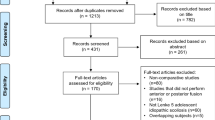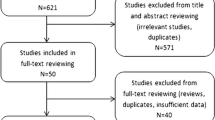Abstract
Background
Debate exists as to whether anterior–posterior spinal fusion (APSF), rather than posterior-only spinal fusion (PSF), provides benefit for treating severe thoracic adolescent idiopathic scoliosis (AIS). This systematic review and meta-analysis compare (1) Cobb angle correction, (2) complication and reoperation rate, (3) pulmonary function, (4) number of fused segments, and 5) patient-reported outcome measures (PROMs) in both groups.
Methods
Electronic databases were searched to identify studies that met the following inclusion criteria: comparative studies (level 3 or above), severe thoracic curves (≥ 70°), age ≤ 16, AIS aetiology, Lenke 1–4 curves and follow-up ≥ 1 year for ≥ 95% of patient population. Literature was graded for quality and bias using GRADE and MINORS criteria.
Results
Eight studies were included, defined by GRADE as low or moderate level evidence. Three studies showed superior curve correction in the APSF group; however, the meta-analysis showed no significant difference in curve correction between groups (95% CI − 3.45–12.96, P = 0.26). There were more complications in the APSF group, without statistical significance (95% CI 0.53–3.39, P = 0.54; I2 = 0%, P = 0.78). There were no re-operations in either group. Two studies reported pulmonary function; one showed better function in the APSF group, the other better function in the PSF group. One study showed fewer fused segments in the APSF group, however, no significance was observed in the meta-analysis (95%CI − 1.65–0.31, P = 0.18). Three studies reported PROMs with no differences reported between groups.
Conclusions
APSF and PSF have been found to have comparable results. The present evidence cannot support recommendations for guidelines on future practice with regards to effect on curve correction, complications, re-operations, pulmonary function or PROMs.
Level of evidence
Level III, Systematic review of Level-III studies.




Similar content being viewed by others
References
Cobb, J. R. (1948). Outline for the study of scoliosis. Am Acad Orthop Surg Instr Course Lect., 5, 261–275.
Dwyer AF, Newton NC, Sherwood AA. An anterior approach to scoliosis. A preliminary report. Clin Orthop Relat Res. 1969; Jan-Feb; 62:192–202.
Helenius, I. (2013). Anterior surgery for adolescent idiopathic scoliosis. J Children’s Orthopaedics, 7, 63–68.
Lapinksy AS, Richards BS. Preventing the crankshaft phenomenon by combining anterior fusion with posterior instrumentation. Does it work? Spine (Phila Pa 1976). 1995; Jun 15;20(12):1392–8.
Lee CS, Nachemson AL. The crankshaft phenomenon after posterior Harrington fusion in skeletally immature patients with thoracic or thoracolumbar idiopathic scoliosis followed to maturity. Spine (Phila Pa 1976). 1997; Jan 1;22(1):58–67.
Coe JD, Arlet V, Donaldson W, Berven S, et al. Complications in spinal fusion for adolescent idiopathic scoliosis in the new millennium. A report of the Scoliosis Research Society Morbidity and Mortality Committee. Spine (Phila Pa 1976). 2006; Feb 1;31(3):345–9.
Vedantam R, Lenke LG, Bridwell KH, et al. A prospective evaluation of pulmonary function in patients with adolescent idiopathic scoliosis relative to the surgical approach used for spinal arthrodesis. Spine (Phila Pa 1976). 2000 Jan;25(1):82–90.
Sudo, H., Ito, M., Kaneda, K., Shono, Y., et al. (2013). Long-term outcomes of anterior dual-rod instrumentation for thoracolumbar and lumbar curves in adolescent idiopathic scoliosis: a twelve to twenty-three-year follow-up study. J Bone Joint Surg Am Vol, 95, e49.
Gitelman Y, Lenke LG, Bridwell KH et al. Pulmonary function in adolescent idiopathic scoliosis relative to the surgical procedure: a 10-year follow-up analysis. Spine (Phila Pa 1976). 2011;36:1665–72
Dobbs MB, Lenke LG, Kim YJ et al. Selective posterior thoracic fusions for adolescent idiopathic scoliosis: comparison of hooks versus pedicle screws. Spine (Phila Pa 1976). 2006; 15;31(20):2400–4.
Qiu, Y., Wang, W. J., Zhu, F., et al. (2011). Anterior endoscopic release/posterior spinal instrumentation for severe and rigid thoracic adolescent idiopathic scoliosis. Zhonghua Wai Ke Za Zhi. (Chin J Surg), 49(12), 1071–1075.
Chen, Z., & Rong, L. (2016). Comparison of combined anterior-posterior approach versus posterior-only approach in treating adolescent idiopathic scoliosis: a meta-analysis. Euro Spine J, 25(2), 363–371.
Luhmann SJ, Lenke LG, Kim YJ et al. Thoracic adolescent idiopathic scoliosis curves between 70 degrees and 100 degrees: is anterior release necessary? Spine (Phila Pa 1976). 2005; 15;30(18):2061–7.
Shi, Z., Chen, J., Wang, C., et al. (2015). Comparison of thoracoscopic anterior release combined with posterior spinal fusion versus posterior-only approach with an all-pedicle screw construct in the treatment of rigid thoracic adolescent idiopathic scoliosis. J Spin Disorders Tech, 28(8), E454–E459.
Pourfeizi, H. H., Sales, J. G., Tabrizi, A., et al. (2014). Comparison of the combined anterior-posterior approach versus posterior-only approach in scoliosis treatment. Asian Spine J., 8(1), 8–12.
Davis MA. Posterior spinal fusion versus anterior/posterior spinal fusion for adolescent idiopathic scoliosis: a decision analysis. Spine (Phila Pa 1976). 2009; 1;34(21):2318–23.
Lenke, L. G., Betz, R. R., Harms, J., et al. (2001). Adolescent idiopathic scoliosis: a new classification to determine extent of spinal arthrodesis. J Bone Joint Surg Am Vol, 83(8), 1169–1181.
Asher MA, Lai SM, Glattes RC et al. Refinement of the SRS-22 Health-Related Quality of Life questionnaire Function domain. Spine (PhilaPa 1976) 2006; 1;31(5):593–7.
Schunemann, H. J., Jaeschke, R., Cook, D. J., et al. (2006). An official ATS statement: grading the quality of evidence and strength of recommendations in ATS guidelines and recommendations. Am J Respiratory Crit Care Med, 174, 605–614.
Rowe, G., & Wright, G. (1999). The Delphi technique as a forecasting tool: issues and analysis. Int J Forecasting, 15, 353–375.
Slim, K., Nini, E., Forestier, D., Kwiatkowski, F., Panis, Y., & Chipponi, J. (2003 Sep). Methodological index for non-randomized studies (minors): development and validation of a new instrument. ANZ Journal of Surgery, 73(9), 712–716.
Higgins JPT, Thomas J, Chandler J et al. Cochrane Handbook for Systematic Reviews of Interventions version 6.2 (updated February 2021). Cochrane, 2021. Available from www.training.cochrane.org/handbook.
Lonner, B. S., Haber, L., Toombs, C., et al. (2020). Is anterior release obsolete or does it play a role in contemporary adolescent idiopathic scoliosis surgery? A matched pair analysis. J Pediatric Orthopedics, 40(3), e161–e165.
Du, J. Y., Poe-Kochert, C., Thompson, G. H., et al. (2020). One stage or two? A cohort analysis of anterior-posterior spinal fusions for severe pediatric scoliosis. Spine Deform., 8(5), 939–949.
Sucato DJ, Erken YH, Davis S, et al. Prone thoracoscopic release does not adversely affect pulmonary function when added to a posterior spinal fusion for severe spine deformity. Spine (Phila Pa 1976) 2009;34(8):771–778.
Zhang, Q., Li, M., Gu, S. X., et al. (2009). Posterior pedicle screw technique alone versus anterior-posterior spinal fusion for severe adolescent idiopathic thoracic scoliosis. J of Clin Rehab Tissue Eng Res, 13(26), 5056–5061.
Choudhry, M., Ahmad, A., & Verma, R. (2016). Adolescent idiopathic scoliosis. The Open Orthopaedics J, 10(1), 143–154.
Mack, M. J., Regan, J. J., McAfee, P. C., et al. (1995). Video-assisted thoracic surgery for the anterior approach to the thoracic spine. Annals of Thoracic Surgery, 59(5), 1100–1106.
Anand N, Regan JJ. Video-assisted thoracoscopic surgery for thoracic disc disease: Classification and outcome study of 100 consecutive cases with a 2-year minimum follow-up period. Spine (Phila Pa 1976) 2002;15;27(8):871–9.
Newton PO, Wenger DR, Mubarak SJ et al. Anterior release and fusion in pediatric spinal deformity. A comparison of early outcome and cost of thoracoscopic and open thoracotomy approaches. Spine (Phila Pa 1976). 1997; 15;22(12):1398–406.
Gaines, R. W., Jr. (2000). The use of pedicle-screw internal fixation for the operative treatment of spinal disorders. J Bone Joint Surg Am Volume, 82(10), 1458–1476.
Storer, S. K., Vitale, M. G., Hyman, J. E., et al. (2005). Correction of adolescent idiopathic scoliosis using thoracic pedicle screw fixation versus hook constructs. J Pediatric Orthopedics, 25(4), 415–419.
Kim YJ, Lenke LG, Cho SK et al. Comparative analysis of pedicle screw versus hook instrumentation in posterior spinal fusion of adolescent idiopathic scoliosis. Spine (Phila Pa 1976) 2004;15;29(18):2040–8.
Charalampidis, A., Moller, H., & Gerdhem, P. (2021). Anterior versus posterior fusion surgery in idiopathic scoliosis: a comparison of health-related quality of life and radiographic outcomes in Lenke 5C curves—results from the Swedish spine registry. J Children’s Orthopaedics, 15(5), 464–471.
Guyatt, G. H., Oxman, A. D., Kunz, R., et al. (2008). What is “quality of evidence” and why is it important to clinicians? BMJ (Clinical research ed)., 336(7651), 995–998.
Guyatt, G. H., Oxman, A. D., Vist, G. E., et al. (2008). GRADE: An emerging consensus on rating quality of evidence and strength of recommendations. BMJ (Clinical research ed), 336(7650), 924–926.
Guyatt G, Oxman AD, Akl EA et al. GRADE guidelines: 1. Introduction-GRADE evidence profiles and summary of findings tables. Journal of clinical epidemiology. 2011;64(4):383–94.
Funding
None of the authors have financial relationships relevant to this article to disclose.
Author information
Authors and Affiliations
Corresponding author
Ethics declarations
Conflict of interest
None of the authors have conflict of interests to disclose.
Ethical approval
Not applicable.
Informed consent
Not applicable.
Additional information
Publisher's Note
Springer Nature remains neutral with regard to jurisdictional claims in published maps and institutional affiliations.
Rights and permissions
About this article
Cite this article
Dwarakanath, L.V., Sewell, M.D., Leung, E. et al. Systematic Review and Meta-analysis: Does Anterior–Posterior Spinal Fusion Still have a Role in Severe Thoracic Adolescent Idiopathic Scoliosis?. JOIO 57, 167–176 (2023). https://doi.org/10.1007/s43465-022-00747-9
Received:
Accepted:
Published:
Issue Date:
DOI: https://doi.org/10.1007/s43465-022-00747-9




